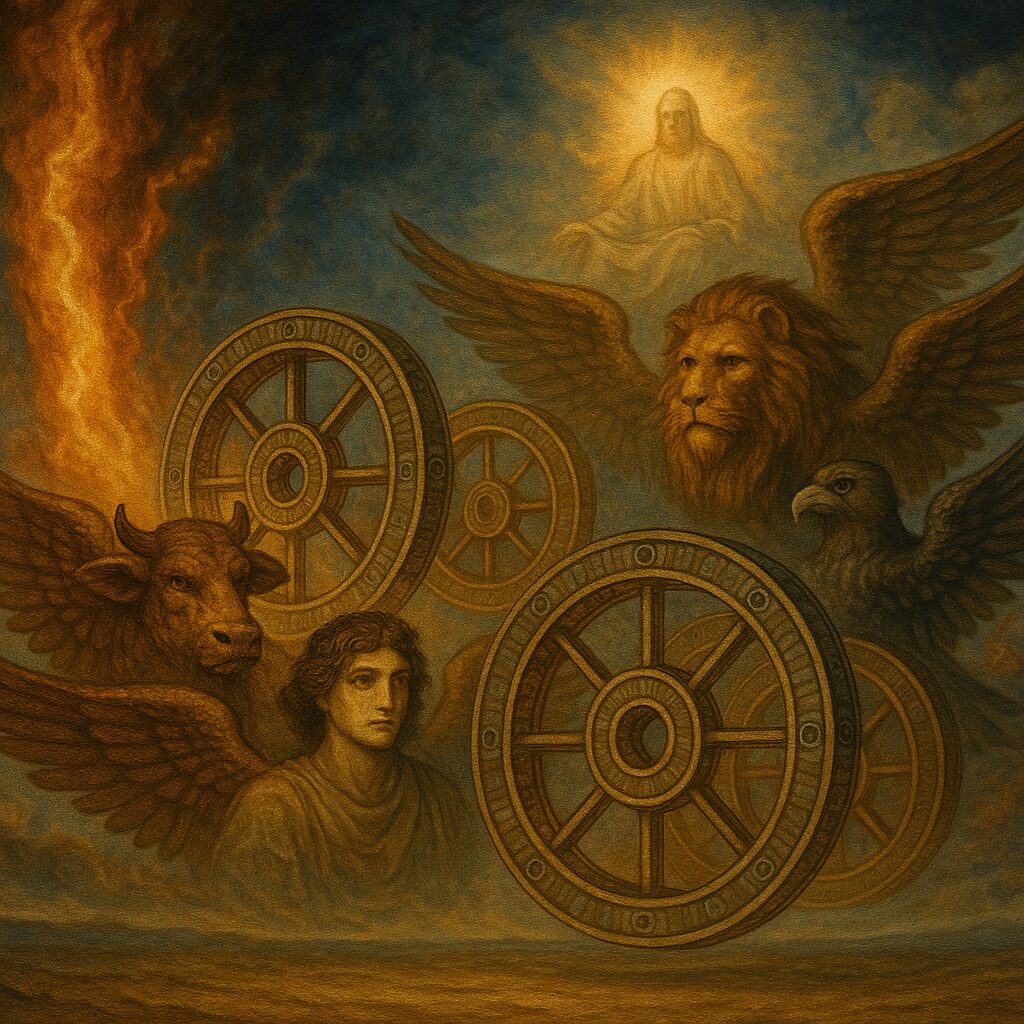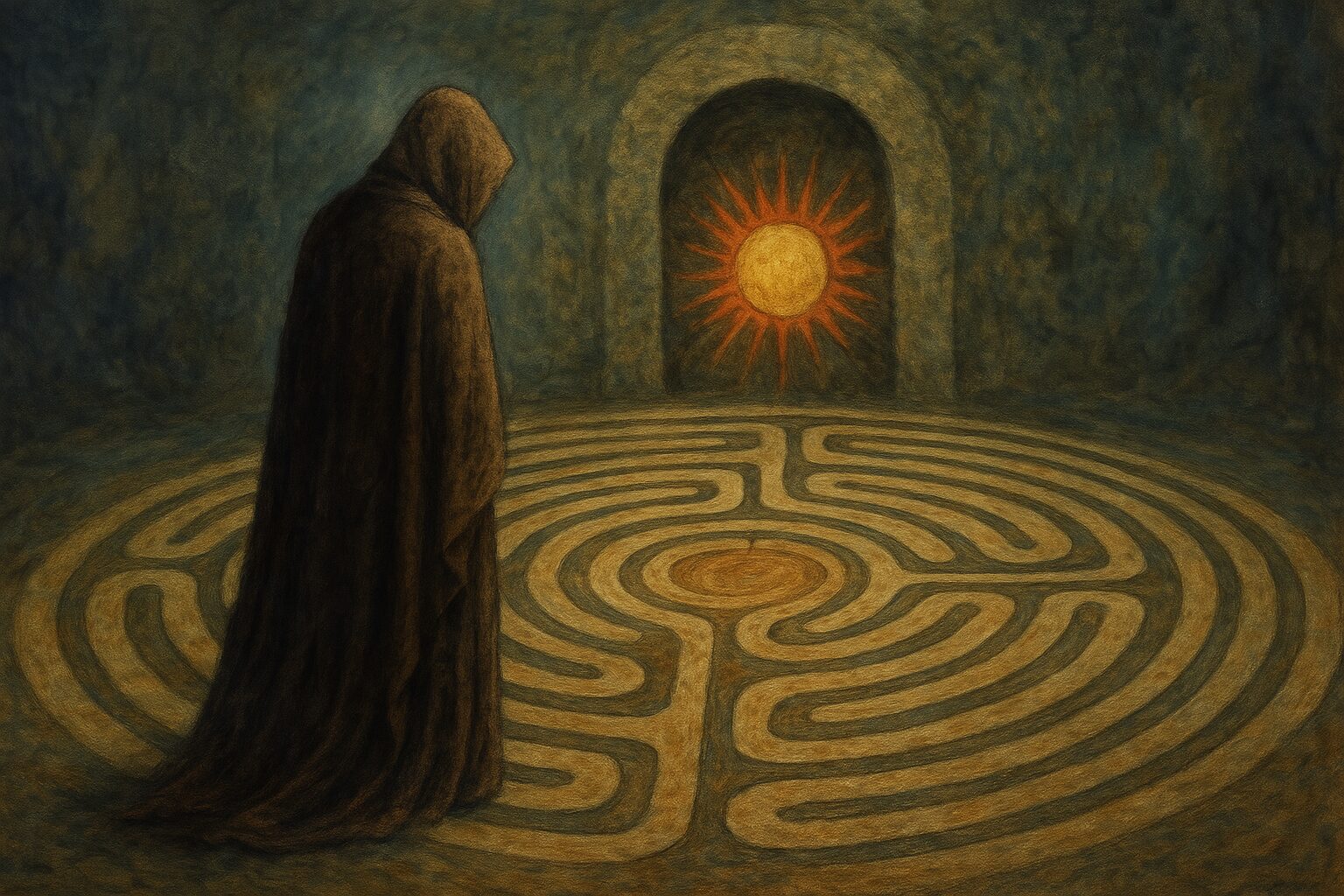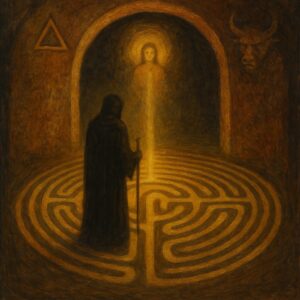High above the sands of Babylon, the prophet Ezekiel beheld a vision that would haunt mystics, inspire Kabbalists, and ignite esoteric imaginations for centuries. A whirlwind came from the north, a great cloud with fire enfolding itself, and in the heart of the fire—wheels within wheels, cherubim with four faces, and a radiant throne above it all.
To the untrained eye, this was madness. To the initiated, it was a map.
The vision of the Merkavah—the divine chariot—has long been seen not merely as prophecy, but as cosmic architecture, a glimpse into the hidden mechanics of the universe and the ascent of the soul through sacred geometry and angelic intelligences.
Wheels Within Wheels: Divine Engineering
In Ezekiel 1:15–21, the prophet describes four immense wheels intersecting one another, each sparkling like beryl. They move in perfect harmony, guided by the spirit. This is no simple vision—it is symbolic machinery, a celestial mechanism beyond human engineering.
The wheels rotate in multiple directions. They are full of eyes. They are alive. They are governed by Ruach Elohim—the spirit of God. In occult terms, this could be interpreted as the interdimensional interface between spiritual and material planes.
Many esoteric thinkers, including early Kabbalists, saw this as the blueprint of a multi-layered universe, composed of concentric realities—each governed by principles more subtle than the last.
The Four-Faced Beings: Archetypes of Creation
Ezekiel’s vision also introduces four hybrid beings, each with the face of a man, lion, ox, and eagle—representing the four living creatures around the divine throne. These faces are not arbitrary. They correspond to ancient astrological and elemental symbols:
- Man: Aquarius (Air) – Consciousness, reason
- Lion: Leo (Fire) – Courage, spirit
- Ox: Taurus (Earth) – Strength, endurance
- Eagle: Scorpio (Water, elevated to the higher octave) – Transformation, mystery
Together, they form a tetramorph, a symbolic representation of the four corners of creation, echoed later in Christian iconography as the four Evangelists. In occult terms, these are the guardians of the cardinal directions, the archetypes of the zodiac, and the energetic guardians of space-time.
The Merkavah: Chariot of Ascent
The Hebrew word Merkavah means “chariot,” and the vision of Ezekiel gave rise to a school of mystical practice known as Merkavah mysticism—a precursor to Kabbalah. This path was not about doctrine but experience: a visionary ascent through celestial palaces toward the throne of the Divine.
Initiates would use visualization, sacred names, and meditative states to ascend the chariot in consciousness, passing through layers of reality guarded by angelic forces. These were not mere metaphors, but intense, secretive spiritual exercises—often accompanied by warnings, because not all who embarked on the journey returned unchanged.
In modern symbolic terms, this ascent maps onto the Tree of Life, with its Sephiroth representing levels of being and awareness.
Sacred Geometry and the Machinery of the Soul
From a symbolic engineering perspective, Ezekiel’s vision could be seen as a sacred schematic—not of heaven as a place, but of the psyche and cosmos as one. The “wheels within wheels” are fractal realities. The eyes in the wheels may be seen as consciousness distributed across dimensions. The faces of the cherubim are the primal forces that shape existence.
This perspective echoes the Platonic idea of forms, the Pythagorean harmony of the spheres, and the Kabbalistic Tree of Life as a cosmic wiring diagram.
In this vision, the soul is not a static point—it is a chariot rider, drawn through heavens by archetypal energies and divine logic. Every dream, symbol, and synchronicity becomes a gear in the great metaphysical engine.
The Living Chariot Within
The most profound insight of the Merkavah vision is not that God rides a cosmic vehicle—it’s that you are the chariot. Your mind is the wheel within the wheel. Your soul is the throne of divine light. Your instincts, reason, emotions, and intuition are the four-faced creatures that carry your being forward.
To awaken spiritually is to align the chariot—to become a vessel worthy of divine presence.
When we integrate our fragmented selves—our shadows, archetypes, ancestral patterns—we begin to move harmoniously, like the vision itself: not turning when we move, but flowing directly toward purpose, guided by a higher intelligence.
Conclusion: A Blueprint for the Ascent
Ezekiel’s vision is not merely ancient scripture—it is an occult diagram, a map of metaphysical ascent, and a mirror of the self. Whether read through the lens of Kabbalah, sacred geometry, or mystical psychology, it remains one of the most intricate and powerful revelations of divine architecture.
To gaze upon it is to risk being changed.
To understand it is to begin building the chariot.



